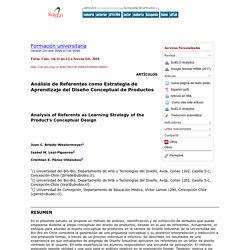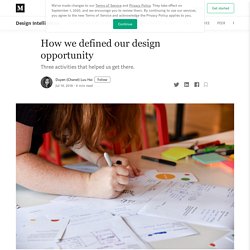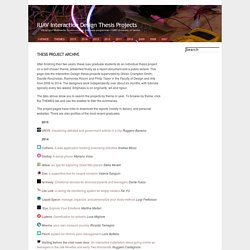

Nudging explained - SUE. Systemic Design Toolkit by Kristel van Ael of Namahn. Live notes from the webinar Keynote: Hands-on with Systemic Design by Kristel van Ael of Namahn during The Virtual Design Thinking BarCamp 2020 held on 25 April 2020.

Read the article to discover how to download the toolkit to help you in facing Wicked Problems. Systemic Design Toolkit. The Systemic Design Toolkit was developed by Namahn’s Kristel van Ael and her team for initial workshopping at RSD5 in Toronto.

We launched the Toolkit at Relating Systems and Design 7, October 2018, after a year or so of partnering with Phillipe Vandenbroeck from ShiftN, Alex Ryan of MaRS Solutions Lab, and myself with Systemic Design Association. Civilian and educational versions of the Toolkit are now in process and used in training. The Toolkit encompasses the progression of knowledge building over the course of 7 RSD conferences, with the methods tested in workshops and now graduate coursework, at OCADU’s Strategic Foresight and Innovation and at U Antwerp, Belgium. The Systemic Design Toolkit is based on design principles and original systems science foundations. to show how methods cannot replace the evolution of one’s own systems thinking competencies in social and systemic design.
On the Toolkit website you can register to access a presentation and canvases for the SD Toolkit. Methods. Methods We’ve lined up a number of activities to help you understand, define, make, and release circular innovations.

Dive in wherever makes most sense for you and your team.Don’t worry about getting it all right on your first go. The more you prototype and learn, the greater your positive impact on the system. Thank you! Toolkits – Social Design. Design+Research. Methods for Synthesis. What is it?

A 2x2 is an organizational diagram used to illustrate how many things compare across two dimensions. Within a single dataset, a 2x2 can show trends, outliers, and areas of saturation and scarcity. In the context of design, this diagram can describe opportunities for impact and areas ripe for innovation. It also can be used to determine the relative quality of design ideas. Because the 2x2 maps one criterion on the x axis and an alternative criterion on the y axis, the grid of four quadrants show all possible combinations of those two criteria. How do I do it? Decide which evaluation criteria are most important for your particular context, and label the axes with this criteria. Next, draw the 2x2 in big scale. Make a card for each data point you are evaluating. When you have about ten data points on the grid, revisit the first few.
Hereafter. Take Your Product Idea From Concept To Manufacturing With This Simple Framework. Instagram. Enabling: laying the table mats - Communication Design for Alzheimer's Disease. Enabling: laying the table mats The third experiment focused on the idea of enabling people with Alzheimer’s disease.

As procedural memory is affected, which deals with tasks and how to do things, simple tasks like laying the table can become quite complex. As a former housewife, my grandmother was always very keen on helping out at home. In the last years, she has been not able to do it anymore. A tablecloth with the silhouettes of the cutlery and crockery was created to see if it this was helpful for her laying the table.
Testing and results The tablecloth was on the table with the plates and cutlery in the middle. Enabling from Rita Maldonado Branco on Vimeo. Citation.crosscite.org/ A Business Design Toolkit — Frameworks, models and other thinking tools I find repeatedly useful. Untitled. Untitled. Untitled. Viewpoints Services Hakuhodo, which has been collaborating with the international cultural, educational and scientific institute Ars Electronica since 2014, commenced offering a variety of services last year through Ars Electronica Tokyo Initiative (AETI).

Here, Hakuhodo Brand & Innovation Design’s Rena Tanaka discusses one of AETI’s range of services, Art Thinking Program, which has seen rapidly growing need recently. Hakuhodo Brand & Innovation Design has been working with the Linz, Austria based international creative organization Ars Electronica to introduce Art Thinking into Japanese society. The Circular Classroom: a Free Toolkit for Activating the Circular Economy through Experiential Learning. Finland is, by many accounts, known as having the world’s best education system, thanks to its no-homework, student-centric, interdisciplinary, life-skills teaching approach, and for its commitment to experiential and phenomena-based learning (more on this here, here and here). So when I was invited last year to work on a progressive initiative to design curriculum focusing on the Circular Economy, sustainability, and creative problem solving for Finnish high schools, I was extremely excited by the potential for this project to have far-reaching educational impacts.
The Circular Classroom is a free, multilingual educational resource for students and teachers alike, designed to integrate circular thinking into high school and upper secondary classrooms in Finland, all packaged up in a fun, beautiful format. I designed the Circular Classroom curriculum materials through a co-creation process utilizing the Disruptive Design Method. Untitled. Untitled. Untitled. Análisis de Referentes como Estrategia de Aprendizaje del Diseño Conceptual de Productos Analysis of Referents as Learning Strategy of the Product’s Conceptual Design Juan C.

Untitled. We then asked the designers to sketch an idea for each prompt for a few minutes before sharing it with the group.

After a few rounds, we generated an overwhelming amount of ideas. We threw out the unrealistic ones and mapped the rest on the two-by-two (see above). By summarizing the concepts that fall under the “sweet spot” of high impact and feasibility, we were able to define our value proposition: Enable people with blindness and low vision to make decisions on the go and help them to confidently move through their world by way of a real-time, location-driven AI assistant. 2. Untitled. A debate is not the same as a dialogue.
IUAV Interaction Design Thesis Projects. After finishing their two years, these Iuav graduate students do an individual thesis project on a self-chosen theme, presented finally as a report document and a public lecture.

This page lists the Interaction Design thesis projects supervised by Gillian Crampton Smith, Davide Rocchesso, Raimonda Riccini and Philip Tabor in the Faculty of Design and Arts from 2006 to 2014. The designers work independently over about six months, with tutorials typically every two weeks. Emphasis is on originality, wit and rigour. The tabs above allow you to search the projects by theme or year. Industrial Design Masters Theses. The Master of Industrial Design program explores design as a vehicle for addressing social, cultural, environmental and other concerns, recognizing that design is not simply a professional service, but rather a way of connecting individual interests and values with a social framework.
Students with undergraduate degrees in other fields or with limited design experience are invited to enter the program during Wintersession as a means of preparing to begin the two-year master’s program the following fall. ID covers a broad range of fields, from product and furniture explorations to design for aerospace and medical applications. Graduate students work independently under the guidance of a faculty advisor and thesis committee, and present their final work verbally, visually and in writing. They also participate in the RISD Graduate Thesis Exhibition, a large-scale public show held annually. Graduate Program Director: Andy Law Follow index Theses/Dissertations from 2019 2019. Untitled. Untitled. The Encyclopedia of Human-Computer Interaction, 2nd Ed.
Untitled. Subtlety and Expressivity Chaired by Nithikul Nimkulrat (OCAD University) The materiality of digital jewellery from a jeweller’s perspective Nantia Koulidou (Northumbria University), Jayne Wallace (Northumbria University), Tommy Dylan (Northumbria University) Wearing Digital Shimmers: A fashion-centric approach to wearable technology. The Encyclopedia of Human-Computer Interaction, 2nd Ed. Untitled. 19 de septiembre del 2007 Mario Bunge Ya había promediado la redacción de esta nota cuando me llegó una invitación de la Universidad de Salamanca par asistir a un acto académico en el que el doctor José María Cerveró Santiago, catedrático de Física Teórica, disertaría precisamente en defensa de lo inútil.
Untitled. Se reconoce como hipótesis, en el proceso de investigación científica, a la idea que se plantea y se propone ser comprobada mediante la experimentación. La hipótesis es uno de los primeros momentos del proceso creativo del cientista, pero es también el más importante: es el eje sobre el cual se direcciona el proceso investigativo, y por lo tanto sin él sería imposible consagrar un buen investigador. Por supuesto que también una correcta experimentación es indispensable para obtener buenos resultados, pero quien no posee los conocimientos (y la experiencia, fundamental para esta cuestión) como para elaborar buenas hipótesis, difícilmente sea un distinguido científico. Características de la hipótesis. Types of Research Designs - Organizing Academic Research Papers - Research Guides at Sacred Heart University. Definition and Purpose Understood more as an broad approach to examining a research problem than a methodological design, philosophical analysis and argumentation is intended to challenge deeply embedded, often intractable, assumptions underpinning an area of study.
This approach uses the tools of argumentation derived from philosophical traditions, concepts, models, and theories to critically explore and challenge, for example, the relevance of logic and evidence in academic debates, to analyze arguments about fundamental issues, or to discuss the root of existing discourse about a research problem. These overarching tools of analysis can be framed in three ways: Ontology -- the study that describes the nature of reality; for example, what is real and what is not, what is fundamental and what is derivative? Untitled. Six Myths of Product Development. Executive Summary Reprint: R1205E Many companies approach product development as if it were manufacturing, trying to control costs and improve quality by applying zero-defect, efficiency-focused techniques. While this tactic can boost the performance of factories, it generally backfires with product development.
The process of designing products is profoundly different from the process of making them, and the failure of executives to appreciate the differences leads to several fallacies that actually hurt product-development efforts. Sistemaderegistrohastalas12 by davidb.pac3. Sistema de registro CPG by Catalina Ballesteros. Sistema de registro ipg. by Alejo Martinez Romero.
CPG Sistema de Registro by Johanna Sierra. Sistema de registro cpg by Jennyfer Galvis. Sistemaderegistrohastalas12 by davidb.pac3. Sistema de registro cpg by Jennyfer Galvis. CPG Sistema de Registro by Johanna Sierra. Sistema de registro CPG by Catalina Ballesteros. The 4 Fields of Industrial Design: (No, not furniture, trans, consumer electronics, & toys), by Bruce M. Tharp and Stephanie M. Tharp. The confusions are understandable. Not only has the profession never had its own television series with a catchy abbreviated title to predicate popular understanding (E.R., CSI: NY, L.A. Cmu systems. Untitled. Desde hace varios años circula este diagrama de Venn que tiene la intención de orientarnos hacia nuestro propósito en la vida (según el que parece ser el autor original), o hacia el concepto japonés de ikigai, que básicamente es razón de ser. Untitled.